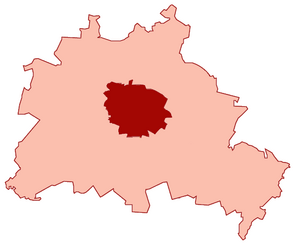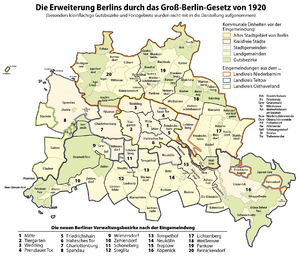Greater Berlin Act facts for kids
The Greater Berlin Act (called Groß-Berlin-Gesetz in German) was a special law made in 1920. Its full name was the Law Regarding the Creation of the New Municipality of Berlin. This law was passed by the government of Prussia, a large state in Germany at the time. It made the capital city of Berlin much, much bigger.
Contents
How Berlin Grew: The 1920 Act
Before 1920, Berlin was part of a region called the Province of Brandenburg. In 1881, Berlin became its own city district, separate from Brandenburg.
The Greater Berlin Act was approved by the Prussian Parliament on April 27, 1920. It officially started on October 1, 1920. This new area, called Greater Berlin, took land from the Province of Brandenburg.
The new Greater Berlin included:
- The old city of Berlin (called Alt-Berlin).
- Seven towns that were next to Berlin: Charlottenburg, Köpenick, Lichtenberg, Neukölln/Rixdorf, Schöneberg, Spandau, and Wilmersdorf.
- 59 smaller towns and 27 special land areas from nearby districts. These districts were Niederbarnim, Osthavelland, and Teltow.
- Even the land where the Berliner Stadtschloss (Berlin City Palace) stood became part of the new city.
Impact of the Greater Berlin Act
This law made Berlin's area 13 times larger! It grew from 66 km2 (25 sq mi) to 883 km2 (341 sq mi). The number of people living in Berlin also doubled. It went from about 1.9 million to nearly 4 million. Almost 1.2 million of these new people came from the seven towns that joined Berlin.
Greater Berlin was then divided into 20 new areas called boroughs (Verwaltungsbezirke). These boroughs helped manage the large city.
The new boroughs included:
- From the old city of Berlin: Mitte, Tiergarten, Wedding, Prenzlauer Berg, Kreuzberg, and Friedrichshain.
- One borough for each of the seven towns that joined: Charlottenburg, Köpenick, Lichtenberg, Neukölln, Schöneberg, Spandau, and Wilmersdorf.
- Seven brand new boroughs created from the other added areas. Each was named after the biggest village in that area at the time: Pankow, Reinickendorf, Steglitz, Tempelhof, Treptow, Weißensee, and Zehlendorf.
Why the Act Was Important
Thanks to this law, city planners could now design and build the whole of Greater Berlin in a planned way. The Act was a key reason why Berlin became a major cultural center in Europe during the 1920s.
The city boundary set by this law is mostly the same today. However, its meaning has changed many times.
- After 1945, it became a dividing line between different occupation zones.
- After 1949, it was part of the Iron Curtain, which separated Eastern and Western Europe.
- From 1961 to 1990, the Berlin Wall stood along some parts of this border.
- Since the Reunification of Germany, it is now the border between the German states of Berlin and Brandenburg.
See also
 In Spanish: Ley del Gran Berlín para niños
In Spanish: Ley del Gran Berlín para niños
- Greater Hamburg Act



